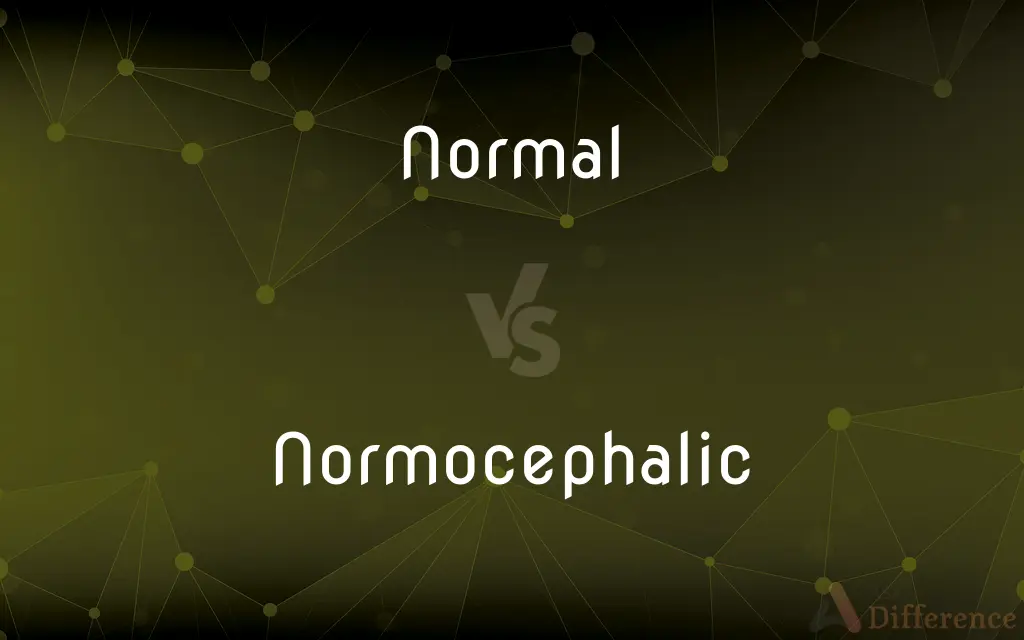Normal vs. Normocephalic — What's the Difference?
By Maham Liaqat & Fiza Rafique — Updated on April 17, 2024
Normal describes typical conditions or behaviors, emphasizing general acceptability; normocephalic specifically refers to a head size within standard medical norms.

Difference Between Normal and Normocephalic
Table of Contents
ADVERTISEMENT
Key Differences
Normal is a broad term used across various contexts to describe what is typical or expected, based on average conditions or societal standards. Whereas, normocephalic is a medical term, specifically describing a head size that falls within the normal range on medical charts and is considered typical for the age and ethnicity of a person.
Normal can apply to behaviors, conditions, or physical attributes, indicating conformity with the most common characteristics observed in a population. On the other hand, normocephalic strictly relates to the measurement of head circumference, used by healthcare professionals to assess normal brain development and overall health.
In everyday language, normal is often subjective and can vary widely depending on cultural, social, and personal factors. Whereas, normocephalic is a precise term used in a clinical context, with specific criteria defined by medical standards.
When people refer to something as normal, they usually mean it does not deviate from what is seen as standard or usual. In contrast, normocephalic is not commonly used outside of professional healthcare settings and is unlikely to be known without a medical background.
Discussing someone as normal in terms of health can have a broad meaning, possibly referring to mental, physical, or emotional health. Conversely, describing someone as normocephalic specifically addresses the absence of abnormalities in head size and shape.
ADVERTISEMENT
Comparison Chart
Definition
Conforming to a standard; usual
Having a head circumference that is within normal limits for age and ethnic background
Usage Context
General, varies by context
Medical, specific
Implication
Typicality in general terms
Specific reference to head size
Required Knowledge for Usage
None
Medical knowledge required
Associated Fields
Broad, including behavior, statistics, norms
Healthcare, particularly pediatrics and neurology
Compare with Definitions
Normal
Approximately average in any psychological trait, as intelligence or personality.
She scored within the normal range on the test.
Normocephalic
Pertaining to having a head circumference that fits within the medically accepted normal range.
The newborn was noted to be alert and normocephalic.
Normal
Adhering to the average or common standard.
It's normal for toddlers to start speaking in two-word sentences by age two.
Normocephalic
Used to describe normal head shape and size in medical examinations.
Upon examination, the child was alert, responsive, and normocephalic.
Normal
Free from any infection or other form of disease or malformation.
The lab results confirmed that the patient is normal.
Normocephalic
Indicating no abnormalities in the shape or size of the head as observed by a healthcare provider.
The physical assessment was unremarkable with the patient appearing normocephalic.
Normal
Free from any mental disorder; sane.
His behavior seems perfectly normal.
Normocephalic
Referring to an essential criterion in pediatric health checks.
The doctor checked to ensure the baby was normocephalic, which reassured the parents.
Normal
Conforming with, adhering to, or constituting a norm, standard, pattern, level, or type; typical
Normal room temperature.
One's normal weight.
Normal diplomatic relations.
Normocephalic
A clinical term used in the assessment of possible developmental issues.
Being normocephalic, the physician ruled out certain cranial deformities.
Normal
(Biology) Functioning or occurring in a natural way; lacking observable abnormalities or deficiencies.
Normocephalic
Having a normal-sized head; neither macrocephalic nor microcephalic; mesocephalic
Normal
Relating to or designating the normality of a solution.
Normal
Abbr. n Designating an aliphatic hydrocarbon having an acyclic unbranched chain of carbon atoms.
Normal
Being at right angles; perpendicular.
Normal
Perpendicular to the direction of a tangent line to a curve or a tangent plane to a surface.
Normal
Relating to or characterized by average intelligence or development.
Normal
Free from mental illness; sane.
Normal
The usual, expected, or standard state, form, amount, or degree
Temperatures have been above normal for this time of year.
Normal
(Mathematics) A perpendicular, especially a perpendicular to a line tangent to a plane curve or to a plane tangent to a space curve.
Normal
According to norms or rules or to a regular pattern.
Organize the data into third normal form.
Normal
(mathematics) Adhering to or being what is considered natural or regular in a particular field or context:
Normal
Usual, healthy; not sick or ill or unlike oneself.
John is feeling normal again.
Normal
Teaching teachers how to teach to certain norms
My grandmother attended Mankato State Normal School.
Normal
(chemistry) Of, relating to, or being a solution containing one equivalent weight of solute per litre of solution.
Normal
(organic chemistry) Describing a straight chain isomer of an aliphatic hydrocarbon, or an aliphatic compound in which a substituent is in the 1- position of such a hydrocarbon.
Normal
In which all parts of an object vibrate at the same frequency normal mode]].
Normal
In the default position, set for the most frequently used route.
Normal
(geometry) Perpendicular to a tangent of a curve or derivative of a surface.
The interior normal vector of an ideal perfect sphere will always point toward the center, and the exterior normal vector directly away, and both will always be co-linear with the ray whose' tip ends at the point of intersection, which is the intersection of all three sets of points.
Normal
(geometry) A line or vector that is perpendicular to another line, surface, or plane.
Normal
A person who is healthy, normal, as opposed to one who is morbid.
Normal
A person who is normal, who fits into mainstream society, as opposed to those who live alternative lifestyles.
Normal
The usual state.
His workload is now back to normal.
Heavy workload is the new normal.
Normal
According to an established norm, rule, or principle; conformed to a type, standard, or regular form; performing the proper functions; not abnormal; regular; natural; analogical.
Deviations from the normal type.
Normal
According to a square or rule; perpendicular; forming a right angle; as, a line normal to the base. Specifically: Of or pertaining to a normal.
Normal
Standard; original; exact; typical.
Normal
Any perpendicular.
Normal
A straight line or plane drawn from any point of a curve or surface so as to be perpendicular to the curve or surface at that point.
Normal
Something regarded as a normative example;
The convention of not naming the main character
Violence is the rule not the exception
His formula for impressing visitors
Normal
Conforming with or constituting a norm or standard or level or type or social norm; not abnormal;
Serve wine at normal room temperature
Normal diplomatic relations
Normal working hours
Normal word order
Normal curiosity
The normal course of events
Normal
In accordance with scientific laws
Normal
Being approximately average or within certain limits in e.g. intelligence and development;
A perfectly normal child
Of normal intelligence
The most normal person I've ever met
Normal
Forming a right angle
Common Curiosities
Can normal and normocephalic be used interchangeably?
No, normal is a broad term, while normocephalic is a specific medical term related to head size.
What does normal mean in everyday language?
Normal refers to what is common, usual, or expected in everyday situations.
Why is it important for a doctor to note if a patient is normocephalic?
It helps in assessing healthy brain development and spotting potential abnormalities early.
What might indicate that someone is not normocephalic?
Abnormal head sizes, which could suggest developmental issues or health problems.
Are there psychological implications to being labeled as normal?
Yes, it can affect perceptions of self and others, potentially impacting mental health.
Is normocephalic a common term outside of healthcare?
No, it is mostly used within professional medical contexts.
What is the definition of normocephalic?
Normocephalic means having a head size that is within the normal range for a person’s age and ethnic background.
What areas of health does the term normal cover?
Normal can pertain to mental, emotional, physical health, and more, depending on context.
How is normality determined in a medical setting?
Through comparisons to statistical averages and health standards.
What does it mean if a child is not normocephalic?
It may indicate problems with growth or development that require medical attention.
Share Your Discovery

Previous Comparison
Want vs. Wont
Next Comparison
Factual vs. UnfactualAuthor Spotlight
Written by
Maham LiaqatCo-written by
Fiza RafiqueFiza Rafique is a skilled content writer at AskDifference.com, where she meticulously refines and enhances written pieces. Drawing from her vast editorial expertise, Fiza ensures clarity, accuracy, and precision in every article. Passionate about language, she continually seeks to elevate the quality of content for readers worldwide.















































